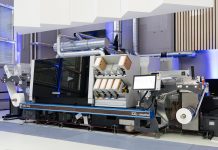Packaging production plays a crucial role in the print industry, despite not always receiving the same level of attention as 3D or functional printing. While packaging may not seem as glamorous, it remains an intriguing and significant aspect of the industry. Let's delve deeper into the challenges that the packaging sector faces, and explore the implications for printers and converters.
Packaging production is a significant sector within the print industry, with its roles evolving over the years. In today's landscape, simply having an attractive design is no longer sufficient to attract customers. Sustainability has emerged as a prominent trend to watch, capturing the attention of both packaging producers and consumers. Despite the upheaval caused by the ongoing COVID-19 crisis, other aspects of daily life are evolving quietly in the background. Let's now turn our attention to the numerous challenges confronting the packaging industry in the present day.
More Flexibility, More Options
Certainly, while the primary function of packaging remains the protection of goods, the methods employed are undergoing significant changes. In the pursuit of sustainability, printers are increasingly turning to thinner materials and more intricate designs. As the delivery methods for boxes become more diverse and complex across various retail formats, packaging production must also adapt to be more flexible, necessitating faster and more efficient machinery. The rapid expansion of the e-commerce sector has presented both opportunities for growth and challenges for the packaging industry in meeting these evolving demands.
The evolution in the packaging industry extends beyond just protecting goods and delivery methods; the presentation of products through creative and innovative packaging has also seen significant advancements. The introduction of new digital solutions has revolutionized the field, empowering packaging designers and converters to achieve feats that were once unimaginable. While digital technologies may not entirely supplant analogue printing, they offer the flexibility required to accommodate shorter production runs, aligning with current industry trends. The demand for customization, security, and traceability has never been higher, and digital solutions make achieving these objectives more accessible than ever before.
Industry4.0 Management
The evolving landscape of new options and enhanced flexibility necessitates an upgraded management system. With the technological advancements available today, achieving this goal is feasible, albeit requiring additional effort and adaptation. Automation plays a crucial role in assisting printers in optimizing machine uptime, facilitating efficient communication between customers and producers, and simplifying the management of diverse equipment interfaces. While having the appropriate machinery is vital, it is equally important to monitor the complexity of the entire workflow.
Utilizing the appropriate workflow automation systems can lead to more cost-effective production processes. As highlighted in our second Spotlight report, effective workflow automation can enhance productivity and reduce costs when implemented correctly. The packaging industry is not immune to cost pressures, as the demand for more value at lower prices continues to grow. To remain competitive, it is crucial that prices do not escalate beyond the current levels. Brand owners seek improved, efficient, customized, and secure packaging solutions to establish a strong market presence, without compromising on pricing. Quality, productivity, and material expenses are three key factors that influence overall packaging production costs. In an integrated workflow, the strength of the production chain is determined by its weakest link, emphasizing the importance of considering these factors holistically across the entire process from design to printing, converting, and packaging.
Bringing the Manpower
Despite the prevalence of automation in the industry, the importance of workforce education and staffing should not be overlooked. Hiring can be a daunting task in the packaging industry, as finding recruits who possess a deep understanding of industry requirements can be rare. However, the introduction of new digital solutions throughout the production process is making packaging production a more appealing field. We frequently highlight these career opportunities in our #PrintingProfessions segments. Additionally, integrating training for existing staff members into workforce planning is crucial to adequately prepare for the challenges that lie ahead.
Successfully addressing the challenges in packaging production necessitates producers to not only scrutinize internal processes but also reassess the overall positioning of their companies. Cultivating a close relationship with suppliers and viewing them as partners is becoming increasingly crucial. Leveraging the Internet of Things, printers can establish direct connections with manufacturers and suppliers to ensure ongoing preventive maintenance. Furthermore, enhancing services between printers and customers is essential. In today's digital age, customers expect a plethora of options at their disposal. It's no longer solely about the product; customers seek a sense of security and excellent care from companies. Therefore, even printers must establish an online presence, offer consultations, and provide quality customer service to meet these evolving expectations.
An Eye on the Future
Sustainability remains a complex and critical issue across various industries, including packaging. It necessitates the creation of intricate designs using thinner materials and advanced substrates, all while maintaining productivity, flexibility, and cost-efficiency. Sustainable packaging production entails achieving optimal waste management through faultless packaging, often referred to as the "Holy Grail" of the industry. However, sustainability goes beyond being "green," "eco-friendly," or "zero-waste"; it also involves establishing enduring, long-term processes. Therefore, it is imperative for printers and converters to stay vigilant about the future trajectory of the print industry.













